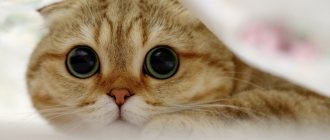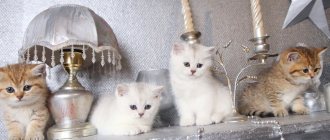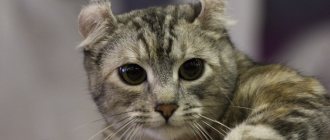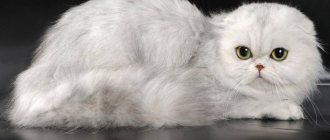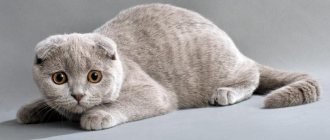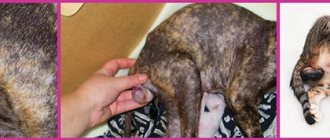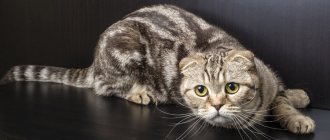The history of the British chinchilla
The history of the origin of British golden chinchillas still causes a lot of controversy. There are several versions of the origin of these animals. According to the first of them, the ancestors of the chinchilla were brought to Britain from Ancient Rome. Followers of this theory are confident that the British are representatives of ancient cat breeds.
However, another part of the researchers is confident that golden chinchilla cats were bred by crossing with other breeds. Such selection work was carried out directly by English researchers. It is believed that the chinchilla owes its thick coat of beautiful color to the crossing of smoky British cats and Persian-colored cats.
This is interesting. Due to the fact that the British chinchilla was created by crossing short-haired and Persian cats, long-haired kittens can be found in the litter. However, the British Longhair cat must meet the same standards as the British Chinchilla.
Gradually, breeders continued crossing, diluting the new breed with the blood of Tabby cats. Experts managed to obtain a golden color using the method described above. But the basis for genetic experiments was no longer Tabby, but a new breed - the magnificent silver chinchilla.
The expectations of specialists were justified, and at the end of the 19th century an animal was obtained that met the golden chinchilla breed standard. These animals were officially recognized only at the end of the 20th century.
Story
The first representative of this color was bred in America in 1880. Therefore, it is not surprising that the United States began to be considered the birthplace of this animal. As a result of crossing an ordinary smoky cat and a silver tabby, a “girl” was born with a very unusual color. It was she who laid the foundation for this breed. Experts could not help but notice the magnificent silver fur, which shimmered in various shades from light to dark. Under the influence of this beauty, they began great work on breeding individuals with a similar color. Today, chinchilla-colored cats are represented in both Persian and British breeds.
Description of the Golden British Chinchilla
The basic characteristics of chinchilla cats correspond to the standards of the British Shorthair cat. The difference between these animals is the length and thickness of the fur; representatives of the first breed.
Appearance
British chinchillas are distinguished by a large, wide chest, strong hips and a straight back. In general, their physique is squat, their muscles are well developed. The weight of cats reaches 5-8 kg, cats 3-4 kg.
The breed standard requires compliance with the following appearance features:
- A rounded head with a wide forehead smoothly transitions into a rounded muzzle with round cheeks.
- The nose is straight, short, with a pinkish nose.
- Small ears, rounded at the ends, set wide apart.
- The neck is muscular and short.
- The round eyes are set shallowly. The ideal eye color for chinchillas is emerald, but yellow and blue shades are acceptable.
- The paws are proportional, muscular, but rather short, and therefore give the impression of being stocky.
- The tail is thick and not too long and ends with a rounded tip.
- The coat is short, thick, and the undercoat is well developed.
There are three main color options for chinchilla cats:
- Silver. Recognized as the most common color of the breed. The belly and chest of cats are almost always white, dark areas are localized on the back, sides and tail.
- Gold. The coat of such cats has a delicate peach tint. These pets are also called the British red chinchilla.
- Shaded silver. Compared to the usual silver color, the animal's fur looks darker. In this case, most of the length of the hairs is shaded, and the undercoat remains white.
This is interesting. Among British chinchillas there are color-point individuals. The colors on the ears, paws and tail of these animals are more “Siamese”, and the color of the eyes is blue.
Character
Golden Britons have a calm disposition. These pets are inactive and do not need constant games and physical activity.
Like all representatives of the cat family, the British have an independent disposition and, at the same time, are attached to their owner. Although chinchillas are affectionate, trusting cats and strive to spend as much time as possible near people, they need a separate place to rest.
Due to the lack of aggression on the part of chinchillas, they are often kept in families with children. These furry creatures almost never hiss and, moreover, do not extend their claws. If a golden cat feels irritated, she will simply move away from the place in which she feels discomfort. Golden chinchillas also get along well with other pets, including dogs or other cats.
For your information. Britons are one of the easiest breeds to train. From the first days of being in the house, this cat adopts the rules of the family in which it happens to live. The pet easily gets accustomed to the tray and scratching post.
Description of the breed (requirements for the standard)
There is no single standard for golden chinchillas. Experts evaluate animals in accordance with the rules of the breed to which they belong. According to the theses of the World Cat Federation:
- British chinchillas are compact, muscular, and massive. The size of the whiskers is medium to large. The body is carried on squat and dense limbs with rounded paws. The Briton's tail must be short, thick and curled up. The wool also looks up. It is plush, made up of dense rows of fine hairs.
The head of the Golden Briton is round and massive, resting on a short and muscular neck. The muzzle is distinguished by a developed chin, a straight nose without a stop, widely spaced round eyes and equally spread round ears.
- Scottish chinchillas come in two subtypes. The Fold is called the Scottish Fold. The tips of the breed's ears are tilted forward and downward. The compactness of the ears and the fit leave them within the round head of the animal with thick cheeks. Scottish Folds also have short and thick legs. The second variety of Scots, called Straight, has limbs of medium length and width. The ears of the mustachioed are straight and can be not only miniature, but also medium in size.
- Persian golden chinchillas are distinguished by their rectangular body shape. It is carried by squat, wide paws. On a short and muscular neck there is a slightly elongated head with a sloping forehead. Other chinchillas have a rounded forehead.
Persian ears have round tips but are set straight. Experts call the expression on Persians' faces "baby faces." It distinguishes representatives of the breed even in old age.
The golden color of chinchillas became the reason for the second name of cats. They are called royal. Therefore, on the Internet there is a description of the “royal chinchilla” breed. Experts will say that this is also a common name for gradient whiskers from different categories.
Contents of a gold Briton
Golden cats of the British breed are suitable for keeping both in a private house and in an apartment. Due to the peculiarities of the coat, shedding in representatives of this breed is almost unnoticeable, especially if it is combed in a timely manner.
Nutrition
Chinchillas can be fed prepared food or natural food.
Important! Under no circumstances should you mix natural food and prepared food. The same prohibition applies to several types of food.
When choosing a dry diet, it is better to focus on super premium or premium classes. Some manufacturers produce lines of food designed specifically for representatives of British breeds, taking into account their needs.
If the owner opted for a natural diet, it should include products such as:
- Raw meat (better lean: veal, turkey). Before serving, it should be placed in the freezer for 12 hours, then doused with boiling water to disinfect it.
- Offal (liver, lungs) boiled or steamed.
- Boiled fish (without bones).
- Low-fat fermented milk products.
- Eggs (preferably quail), 2 times a week.
- Cereals (rice, buckwheat, etc.).
- Vegetables.
The following should be excluded from your pet's diet:
- smoked meats, sausages;
- canned food;
- salty, spicy foods;
- raw milk.
Chinchillas' diet must be balanced. If the animal prefers natural food, vitamin complexes should be added to it from time to time. Drinking water should always be located near the food bowl . It should be changed daily.
How many times a day should you feed your cat?
Chinchillas are prone to overeating and subsequent obesity.
These animals do not know moderation in food, and therefore the dose of delicacy offered to them should be accurately measured. If we are talking about dry food, its quantity must correspond to the data in the table on the package. The amount of natural food is calculated based on the weight and activity of the pet. Leftovers left uneaten by the animal are immediately removed from the bowl. Small kittens eat 6 times a day. Gradually, the number of feedings is reduced, and the animals switch to the feeding regime of an adult cat. The latter are fed 2-3 times a day in small portions.
Walks
The number and duration of promenades depends on the cat's temperament. Some golden pets are content to stay indoors; they are not at all drawn to the street. And other four-legged animals are not at all averse to getting to know the world outside the home.
A chinchilla should be walked on a leash. Before going for a walk, you should take care to protect your animal from parasites. Collars, drops and other means are suitable for this purpose.
Toilet
The golden British chinchilla visits a tray of any size and capacity. Since animals are quite impressive in size, it is better to choose a stable and large toilet for them. Any filler can be used.
Advice. When training a kitten to use the toilet, at first you should purchase the litter that the baby is accustomed to in the nursery. A conscientious breeder, when transferring the baby to a new owner, will provide the latter with all the necessary information.
Character
The golden tartan's favorite pastime is to be close to its family, actively participate in the owner's life, or just be nearby. Prefers any activity related to a person, but it does not get boring, requiring attention and affection.
She does not tolerate loneliness well; if she is left alone at home, she will get bored and seek companionship. The devotion of the golden Scottish cat is so great that after separation she will not take revenge on her owner, but will gratefully curl up at his feet.
The character of the Golden Scotsman is flexible, loving, compliant. A kind cat gets along well in a family, charms everyone, becoming everyone's favorite. He is friendly towards all family members, but he chooses one owner as his favorite, preferring to spend more time with him.
The Golden Scottish Chinchilla has an innate aristocracy. The animal will never scratch the furniture, climb the curtain, or go to the toilet past the tray. Behavior is mannered, gait is smooth, imposing, with a sense of self-esteem.
He is afraid of heights, so fragile things can be safely put on a shelf.
The Scottish chinchilla has intelligence, the ability to learn, and developed intuition. She observes what is happening, draws conclusions, and treats strangers selectively.
For children who do not offend her, she will be a friend. She retains her playful character until old age, is sociable, friendly, and not vindictive.
Cats of this breed are extremely active and curious. They love active games, happily chasing a ball or imitating “catching up” with a toy. Therefore, your pet needs to buy bright toys, balls, and artificial mice.
Need to know. The Golden Scottish Chinchilla prefers to live without the proximity of other living creatures. If birds, fish or small rodents live in the house, she may hunt them.
Appearance care
Complete care for the appearance of a British chinchilla consists of several activities that should be carried out strictly.
Combing
The coat of golden chinchillas includes guard hair and undercoat. Such a multi-level cover needs careful care. Combing is carried out first in the direction of hair growth, and then against the grain. This procedure is performed twice a week, using a special glove or a fine-toothed comb.
Bathing
Despite the fact that the coat of golden chinchillas is quite light, it does not get dirty very often. Therefore, there is no need to bathe your pet often - once every 3 months is enough.
For washing, special shampoos and softening conditioners are used. If there is an urgent need, you can use dry products for washing cat fur, which are selected taking into account the color of the pet.
Ear care
Chinchillas' hearing organs should be carefully examined every 2 weeks. Ear care involves removing dirt and dark plaque using cotton wool. The latter should be moistened with a special composition intended for caring for the ears of cats.
Eye care
The visual organs of British chinchillas require careful care, as they tend to bleed profusely. This process is explained by the original structure of the animal’s tear ducts.
Pets' eyes should be examined regularly to prevent clots from accumulating in the corners. Every morning, the animal’s eyes are wiped with a cotton pad soaked in a solution of boric acid, warm boiled water or a decoction of herbs.
If suppuration is observed, it is permissible to use tetracycline ointment. Progressive eye pathologies require immediate attention to a veterinarian.
Nail care
The claws of golden cats are trimmed once every 2-3 weeks, using special scissors called nail clippers. The pet can remove keratinized particles themselves using a scratching post installed in the room. The latter must be stable and securely fastened.
Dental care
To prevent possible problems with the Briton’s gums and teeth, his oral cavity should be treated once a week. A soft, flexible brush and toothpaste that does not require rinsing are suitable for this purpose.
Features of the breed and character of the cat
The chinchilla cat is an animal that has a very peaceful character. He quickly becomes attached to his owner and even gets along well with dogs. Birds living in the house will also leave the cat indifferent. Although the fold-eared cat is very active and will happily play with children, whom he does not show the slightest bit of aggression, but rather treats as if he were his own kittens.
Owners practically don’t hear the animal’s meow; they “talk” very quietly and unobtrusively. They also treat loneliness calmly. But they will stay with the owner, no matter what. When he is at home, they will patiently do all the household chores with him and wait until they are finally petted.
Purchasing a British Golden Chinchilla kitten
Purchasing purebred British chinchilla kittens is not easy. It is better to choose purebred representatives in trusted nurseries or by contacting reliable breeders who breed this particular breed.
Attention! When purchasing an animal on the market or through a private advertisement, there is a high risk of being deceived and becoming the owner of an ordinary kitten with an unusual color.
Criterias of choice
When choosing a British chinchilla kitten, you should consider a number of recommendations:
- Carefully study the breed standard.
- Make a list of breeders and nurseries. Study reviews about them, become familiar with the peculiarities of keeping animals.
- Be sure to look at the kittens' parents, taking into account their compliance with the breed standard. The breeder will certainly provide a pedigree confirming the purebred of the sires up to the 4th generation.
The immediate choice of a kitten should be approached by paying attention to some features:
- Behavior. When a kitten sees a stranger, it should not try to hide in a corner in horror. A healthy baby is cheerful and inquisitive.
- Appearance. The kittens' coat should be shiny, their eyes and ears should be clean, and their nose should be moist.
- Relevant documents: metrics, pedigree, veterinary book, etc.
At what age is it better to adopt a kitten?
Conscientious breeders hand over kittens to new owners no earlier than 3 months .
Babies of this age can already feed themselves and are also trained to use a tray.
Owner reviews
Kate
I was given a golden British chinchilla for my birthday. This is probably the best gift of my entire life, my miracle. She's just like a toy, plush fur. And her chic golden color simply does not allow you to take your eyes off her. She has already become a member of our family. I feed her Royal Canin. She likes. It is clear that the food has arrived. Her coat is shiny, and she herself is very active. You really get fat quickly.
Marina
Our neighbor upstairs has a chinchilla cat. They bought it at an exhibition somewhere. I think this breed of chinchilla cat is called the British Silver. The neighbor doesn’t let him outside because we have a lot of ordinary cats in our yard, she’s afraid of ruining his pedigree. Sometimes the children and I go to see it. It's just lovely. His silver fur and very bright eyes make him look like a doll. It seems that he is not real. He meows very rarely, such a calm, beautiful cat. Of course, we won’t buy one for ourselves, because I’m afraid the children will squeeze it. And so, of course, we are all in love with our neighbor Patrick.
Zoya
I never knew before that there were such beautiful cats. When my husband showed me a golden chinchilla cat on the Internet and asked if I wanted one, I replied that, of course, yes. We went to look for one of these in nurseries, but it turned out to be not so easy. Such a handsome golden man costs a lot of money. He is easy to care for, we feed him special food, sometimes we give him cottage cheese and fish. Now she’s thinking about buying another silver chinchilla, but I’m afraid that they might quarrel.
Tatiana
There is a woman living in our building who bought a golden chinchilla cat at an exhibition. She took a very responsible approach to choosing a pet and always wanted to participate in exhibitions with this cat. When she brought it home, we asked to see it. I have never seen such beautiful cats in my life. The cat is not just golden, it is some kind of copper-peach-gold. Each of his hairs is stretched with a gradient of color. And to the touch it is just an incredibly soft plush toy. Now the cat is 2 years old and his owner takes him to various exhibitions, where he sometimes wins first places.
Video
Breed defects
British chinchillas are not very sick animals, their health is strong. However, genetic diseases that appear as a result of inbreeding are typical for the breed.
Tendency to diseases
British Chinchilla cats may be susceptible to certain diseases, including:
- Retinal atrophy. It is considered a hereditary pathology and can cause decreased vision or loss of vision.
- Polycystic kidney disease. A hereditary disease accompanied by the formation of fluid cysts. At the same time, the quality of blood purification deteriorates, which can provoke intoxication, sepsis and death.
- Hypertrophied cardiomyopathy. Hereditary pathology of the cardiovascular system. Can lead to blockage of blood vessels, pulmonary edema and death of the animal.
You can avoid purchasing a pet with genetic abnormalities by contacting a trusted breeder. At the first alarming symptoms, the cat should be immediately shown to a veterinarian.
Defects in appearance
The following are recognized as serious defects in the appearance of chinchillas:
- thin, sunken cheeks;
- obvious depression on the nose;
- sparse or excessively soft wool;
- high-set ears;
- excessively elongated muzzle;
- flat forehead.
Some shortcomings exclude the British from participating in the competition. These include:
- skeletal deformities;
- deafness;
- blindness;
- anomalies of the eyelids, teeth, jaws.
For your information. Chinchilla coloring has a number of nuances, and certain requirements are imposed on it. Only a specialist can understand the intricacies of animal coloring.
Health
Like any other purebred cats, the British golden chinchilla has a number of features - diseases inherent in this breed. They are prone to obesity, the risk of polycystic kidney disease, hypertrophic cardiomyopathy and retinal atrophy.
In order for your golden chinchilla to delight you with its purring for a long time, you should pay close attention to your pet’s health - do not skip vaccinations and contact a veterinarian if you notice any change in the cat’s well-being.
If you do not plan to breed a golden chinchilla cat, it is better to castrate and sterilize the cat - this will reduce the likelihood of cancer of the reproductive system. This operation is performed no earlier than 7-8 months of life and, given the genetic predisposition to heart complications, it is recommended to conduct an ultrasound diagnosis of the heart before sterilization.
The first vaccination of a golden chinchilla kitten is carried out at the eighth week of life. Vaccinated against feline distemper, rhinotracheitis and calicivirus infection. Repeated vaccination is carried out after another 21-28 days and, in addition to vaccinations against these diseases, includes a rabies vaccination. Vaccination should be repeated regularly, every year, at the same time.
Breeding the British Chinchilla breed
Breeding British chinchillas is quite a complex matter. For this reason, it is recommended that only experienced breeders engage in it.
Criteria for choosing a partner
Finding a suitable pair for a chinchilla is quite problematic due to the small number of the breed. The offspring are characterized by deviations in color, and therefore crossing is carried out by a limited number of individuals and only among the chinchilla variety.
A potential mating partner must meet certain criteria:
- absence of gene pathologies;
- availability of the necessary documents: veterinary passport, pedigree, breeding permit, etc.;
- deworming, vaccination (must be carried out 2-3 weeks before mating).
The chosen "groom" or "bride" must correspond to the characteristics of the breed, especially with regard to coloration.
At what age should you give your pet for the first mating?
British chinchillas reach sexual maturity late. In view of this, mating should begin when the pet is 20-24 months old. Excessively early birth will not have the best effect on the cat’s immature body. In addition, the offspring in this case often turns out to be weak or non-viable.
Scottish chinchilla, comparison with the golden chinchilla breed, features of the breed
The Scottish chinchilla (cat/cat) differs in character from other representatives of the subspecies. The ears should be compact, lop-eared and tilted forward in accordance with the breed standard.
Lykoy cat or werecat
The coat is medium length and has a plush feel to the touch. The undercoat is white, the paw pads are dark. The eyes, lips and edges of the nose of the Scots are outlined in black, which visually makes them stand out.
The muzzle should be chiseled and large in size, the ears should be pressed tightly to the head.
Unlike the golden chinchilla, the Scottish subspecies has a more docile character and is the owner of a rarer color.
Interesting! The Scottish Chinchilla cat is bred in only two categories (by color): shaded and ticked.
Ticked dyeing is incomplete painting of fur hairs. It consists of at least 3 primary colors that correspond to a specific color. Among the Scots, ticked kittens are quite rare. They cost much more than the regular or shaded color type.
Shaded type of coloring is a type of coloring in which only 1/3 of the cat’s hairs (on top) are painted dark. The rest is completely white. This means that representatives of such an unusual shade have a white (or light) undercoat. The shaded part of the color extends to the back, tail (lower part), tummy, muzzle, ears and head.
Fold-eared chinchilla
Scottish Golden Chinchilla Scottish Fold
The main color of the wool has a gradient dyeing method. The “golden chinchilla” color extends only to 1/8 of the entire body. The remaining places are either not painted or have a pale tone. The main color pigment is usually concentrated in the animal's undercoat.
Scottish Silver Chinchilla Scottish Fold
Kittens are not born with a silvery coat. Baby fluff is bright white. When babies are 2 weeks old, the fur begins to acquire a characteristic grayish tint. By 3 months, the ears begin to droop. The Scottish Silver Chinchilla is highly valued by breeders.
Important! Not all kittens in a litter will have floppy ears. All representatives are born with erect ears, which may bend by 3 months, or may remain erect. Fold-eared babies will be classified as Scottish Folds, and straight-eared babies will be referred to as Scottish Straights.
Scottish fold chinchilla
Scots may have green eyes according to the breed standard. Sometimes kittens with blue irises are allowed.
Interesting! Babies can be born with blue eyes, but the shade and color changes until the cat is 2 months old.
British chinchilla
Scottish Straight, golden chinchilla color
The color has a slight shaded dark or black color on many parts of the body. Thoroughbred representatives are distinguished by a gradient color: from a pale peach color there is a smooth transition to darkened (black) tips of the coat. The characteristic golden hue should be evenly distributed over the cat’s body, and not completely paint over a specific area. The formation of stains is unacceptable.
Scottish Straight, silver chinchilla color
Just like the Scottish Fold, it has a snow-white color without spots or dark hairs. There is dark eyeliner on the eyes, nose and ears, which makes the muzzle visually more pronounced. Ticked coat color is very rare, so the price for a cat will increase significantly.
GOLDEN BRITISH: TYPES OF GOLDEN COLOR BRITISH CATS
The British golden color comes in the following types:
- shaded;
- veiled;
- tabby (ticked, spotted, striped, marbled).
The veiled, shaded and ticked color of the British is also called chinchilla.
| Golden veiled color of British cats | Golden shaded British kitten | Golden ticked British cat |
| Golden spotted British cat | Golden tabby (brindle) color of the British | Golden marbled British kitten |

